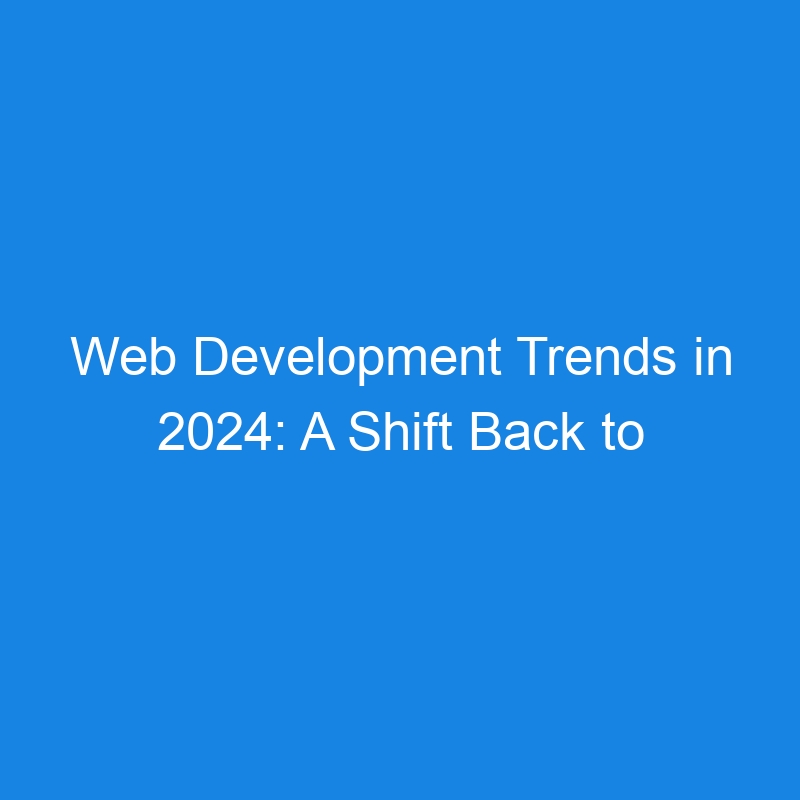
The year in web development was characterized by a return to simpler ways of building a website or web application. Partly this was a reaction against the increasing complexity of JavaScript frameworks — especially React-based frameworks. Simpler options like Astro and Eleventy became more popular over 2024, leading some (well, me anyway) to posit that we’re approaching a post-React world.
Of course, not every web developer was willing to turn away from React — and no ongoing argument demonstrated that better in 2024 than the great Web Components debate.
Making development less complex was also a byproduct of AI integration in dev tools, which enabled even inexperienced developers to tackle hard coding problems with apparent ease. That said, AI comes with its own set of problems — and web publishers and operators, in particular, suffered from the AI takeover this year.
So let’s dive in and take a deeper look at five web development trends of 2024.
1. The Rise of Less Complex Web Frameworks
In January, Netlify CEO Matt Biilmann told attendees of TheJam.dev conference that Jamstack needs to lose the complexity and get simple again. He said that Jamstack tools and processes have gotten much more complicated over the past several years. This became apparent, he noted, when hybrid architectures began infiltrating Jamstack — when there is a mix of client-side and server-side programming.
Biilmann talked about the “two paths to simplicity.” The first path is what he called “pre-baked Jamstack,” by which he means using a build tool to send content to a CDN (content delivery network). This is basically what the initial vision for Jamstack was, before hybrid approaches took over. The second path to simplicity, according to Biilmann, is to “embrace server-side rendering” (SSR). He recommended Astro and Remix as two good frameworks for simplifying development.
Astro was certainly among the trendier web frameworks this year. One of its standout features is that it doesn’t use as much JavaScript as other popular frameworks. It has “zero JS, by default” — which means that Astro components don’t render on the client, but instead “render to HTML either at build-time or on-demand using server-side rendering (SSR).”
Astro offers a kind of ‘back to basics’ approach to web development that harkens back to early Web 2.0 frameworks, like Ruby on Rails and Django, which were also server-rendered.
Note that Astro started out as a static site generator (SSG), but has moved beyond that now. But for most websites or web apps, an SSG — like Eleventy or Nue — is more than sufficient.
It’s worth also mentioning Vue as another good option. Like Astro, it doesn’t try to shoehorn everything into JavaScript — although advanced JavaScript is available if you need it. This kind of simple-first approach to web development is gaining traction, and I expect that to continue in 2025.
2. Post-React World
2024 happened to be the tenth anniversary of React. In a July post, I looked back on the legacy of React and where it sits in the web development landscape now. I concluded that despite its clever innovations — in particular, its“virtual DOM” approach — it has become overly burdened with complexity.
I used the term “post-React” somewhat tongue-in-cheek because React — and associated frameworks like Next.js — are still enormously popular. But there is a sense that developers have viable alternative approaches to choose from now. Neither Astro (mentioned above) nor Svelte uses the virtual DOM approach, so developers can now choose a web framework that doesn’t rely on React (although Astro still has React as an option).
Also, newer React features, like React Server Components, have created a lot of debate among the web community. Igor Minar, one of the creators of the Angular framework and now senior director of engineering at Cloudflare, even went as far as to say, “One thing that is clear to me is that React Server Components will destroy React.”
3. Web Components Love and Hate
Some engineering teams are moving off React and starting to use more web-native approaches. Take the “HTML-first” approach that the Microsoft Edge browser team is pursuing, which Microsoft engineer Alex Russell described as “a modern Web Components + HTML-first architecture.”
At the end of May, Microsoft announced WebUI 2.0, “an entirely new markup-first architecture that minimizes the size of our bundles of code, and the amount of JavaScript code that runs during the initialization path of the UI.”
Less JavaScript means a smaller footprint, which translates to faster web experiences for users. Other, smaller, dev teams are using a similar approach too. In June, I interviewed a senior developer from a Swiss IT company called Eukleia, which is building a custom developer tool called Mindsapp. The company streamlined its app by moving from React to modern web technologies, including web components, resulting in much faster load times for users.
This is all well and good, but many developers don’t like working with web components. In October, Ryan Carniato, creator of the SolidJS JavaScript framework, wrote a blog post with the provocative title, “Web Components Are Not the Future.” Essentially, his argument was that a framework like SolidJS is able to do more than web components in certain scenarios and is easier to implement. He dismisses web components as “a compromise through and through.”
In reply to Carniato, Shoelace creator Cory LaViska argued that web components offer stability and interoperability. LaViska also pointed out that web components don’t do all the things framework components do “because they’re a lower-level implementation of an interoperable element.”
As usual, no minds were changed on the battlefronts of social media.
4. AI Everywhere
It wouldn’t be a review of 2024 in tech without mentioning the almost overwhelming influence of generative AI.
For developers this year, AI got integrated into the core tools of developers (IDEs), while new techniques for creating “AI agents” arose in secondary tools like LangChain and LlamaIndex. The types of LLMs available also became more varied, with smaller models and local development capabilities of particular interest to developers.
AI-assisted coding has had the biggest impact on developers this year. “This is one of the most fast-moving spaces I have seen in my entire career in software engineering,” Madhukar Kumar from SingleStore recently told The New Stack. “We see new tools, IDEs, and full stack development platforms replace IDEs that were popular just a few months ago (case in point, GitHub Copilot). For developers, the biggest challenge will be to keep up with these changes and to keep adapting their workflows to suit their level of experience and what they are building without incurring ‘new-IDE-fatigue.’”
See my year-end wrap-up last week for a deeper look at AI engineering trends in 2024.
5. Web Publishing Existentialism
It was a particularly stressful year for web publishers and operators, who not only had to deal with the encroachment of AI, but also a major drama in the biggest open source web publishing community in the world. When WordPress co-creator Matt Mullenweg and WordPress vendor WP Engine waged legal war with each other, it prompted many operators to look for alternatives to WordPress.
By the end of the year, Google AI Overviews (AIO) — where Google’s AI engine attempts to answer your query at the top of a search results page — was available in more than 100 countries. However, it remains difficult to evaluate the impact. How often does your website show up in AIO? How many times are your citation links in AIO clicked on? Jim Yu from the SEO firm BrightEdge told us that AIO acts like “zero-click quick answers on steroids,” — implying that people aren’t necessarily clicking on citation links. He said that AIO is likely reducing click-through rates, because its AI summaries aim to answer a query directly.
Drupal creator Dries Buytaert offered some hope to publishers in another TNS interview. “You have to deliver value beyond what a ChatGPT can provide, so that people are still incentivized to come to your website,” he said in February. “So how do you do that? By having better content — and better content could be personalized content, or […] it could also be that more content goes behind… not necessarily paywalls, but gates. You know, maybe you need to sign up to get the content.”
Conclusion
Things are never simple in web development, but there were at least the beginnings of a move away from React complexity. Let’s hope that continues in 2025. Meanwhile, the advancement of AI and the continued ructions in web publishing software promise a rocky start to the new year for many web practitioners.
The post Web Development Trends in 2024: A Shift Back to Simplicity appeared first on The New Stack.
